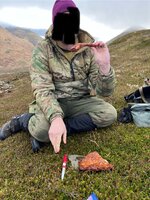- Joined
- Oct 22, 2014
- Messages
- 13,482
I have been asked repeatedly about the performance and differences between quality down, especially treated down; and quality synthetic- Climashield Apex.
The examples here are a Stone Glacier Grumman and a Kifaru Lost Park Parka (LPP). The Grumman is 6 years old, and the LPP is 7 years, however the LPP has less overall use time due to what is below. Both have been used about the same give or take. The Kifaru more on ranges and general wear, the SG more on hunts.
For stated “warmth” that means sitting and glassing for hours without moving, no shaking, no rubbing hands, etc- think sleeping bag. As comfortable as siting at home. Not in the sunlight, so think overcast day.
This is using a standard thin base layer and normal mid layer- Patagonia waffle top, Sitka Kelvin Active or other lighter weight Alpha insulation, etc. under it. Out of the wind, or with a wind shirt over, full belly; legs, feet, head and hands all taken care of.
The comfortable temp range is not based on just my use and thoughts. It is dozen of people. For females and children you can add 5-10° to the listed value for true comfort.
First the Lost Park Parka:
Warmth: 35°-40°ish F when new. After approx 90 days it is a 45° to 50° at best.
The LPP is probably the “best” synthetic standard weight, normal production jacket on the market. At least it is my preference. The RhinoSkin material is durable except for heat (of course), and Climashield Apex insulation is quite good, if a bit heavy, when new.
The issue is that all synthetic insulation has a relatively short lifespan- this includes Apex. I have owned and used multiple LPP’s, and have seen several dozen used consistently and they lose about 40-50% of loft in approx. 90 days of use- sitting in a chair, hunting, stuffed in a pack, etc. At 30 days of use the lost loft is noticeable, and at 60 days I would not take one on a legit hunt where insulation matters- late season elk in cold weather, sheep hunting, etc.
In rain or when wet, standard synthetic performance.
The Multicam on the left is brand new, the tan is the old one, and has had this level of loft since about 90 or so days of use/ it has not lost anything noticeable since then-
They are laid down under their own weight- not puffed up or pushed down at all
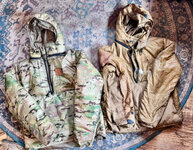
The difference in loft between the new one on the left and the used one on the right is around 90 days of use-

New loft is 1.3” to 1.4”-
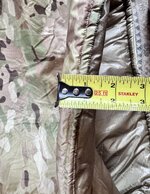
Used is .6” to .7” at most-
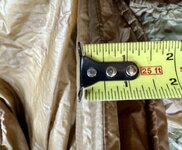
Stone Glacier Grumman:
Warmth: 35’ish degrees. After approximately 900 days of use (150 days times 6 years), it might have dropped a couple of degrees to 35°-38°.
No noticeable loss in loft from new. The only difference between a brand new one and the old one is that when compressed in a stuff sack, the old one takes 5-10min to fully loft up, and new ones fully loft in 30sec to 1 min.
In rain or when soaked, it took about 4 to 5 years of use (600 days) and 7-8 washings before loss of loft when in rain was noticed. The first couple of years even when dunked in water or sitting for hours in rain, loft remained virtually unchanged. It still dries quickly- about as fast as synthetic, and way faster and easier than standard down, or other treated down I have used.
Gold on left is brand new, grey on right is old-
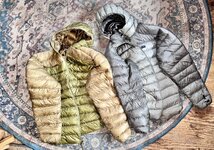
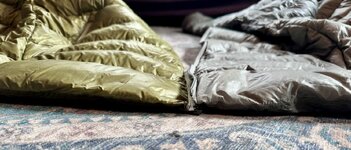
Brand new is .9” to 1” of loft-
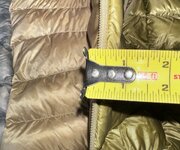
Old is .9” to 1” of loft-
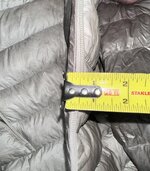
Main differences:
Longevity- after 6 hard years of use that almost no one would use a down jacket for, the Grumman basically remains as good functionally as when new. There has been no issue with wearing out, or wt weather performance problems. The Kifaru LPP which is great when new, has noticeable degradation in loft and warmth by 30-60 days.
Durability:
The Pertex fabric of the Grumman is fantastic for a lightweight shell. No major tips, and small holes close up with a bit of water. However, it like all down jackets (all puffies) aren’t meant to bust brush nor crawl for distance in the ground. The face fabric or good, but if torn the down will come out. In contrast, the synthetic is more forgiving of larger tears and abrasion because even when it gets torn, the insulation won’t come out- if you look at the tan LPP it has a large burned spot by the zipper and multiple patches. If you look at the grey Grumman it has multiple patches on the sleeves.
Both are fine as a puffy jacket. If you do silly things like wear a puffy while going through thorn/brier thickets, synthetic will handle it “better”, that is- it’ll tear, but you won’t lose insulation. The answer here is use puffy for what it is made for- static insulation.
Conclusions:
Everything stated about the Kifaru LPP can be translated to any other jacket that uses the same fill of Climashield Apex insulation. But, it will generally perform better than almost all other synthetics. In contrast, the water resistance and ability to dry out after being soaked of the Stone Glacier Grumman cannot be applied to other down garments. I have not used all the treated down options, but I have used a bunch and non have down as well as SG’s. SG’s down products are the only down insulation that I do not worry about water any more than synthetics.
If the use is for ranges, crawling around, and abusing it where warmth and weight doesn’t matter all that much, the LPP is excellent and by far my preference. However, if insulation longevity in use, warmth, weight, pack size, etc., matter-quality down is objectively and significantly better.
The examples here are a Stone Glacier Grumman and a Kifaru Lost Park Parka (LPP). The Grumman is 6 years old, and the LPP is 7 years, however the LPP has less overall use time due to what is below. Both have been used about the same give or take. The Kifaru more on ranges and general wear, the SG more on hunts.
For stated “warmth” that means sitting and glassing for hours without moving, no shaking, no rubbing hands, etc- think sleeping bag. As comfortable as siting at home. Not in the sunlight, so think overcast day.
This is using a standard thin base layer and normal mid layer- Patagonia waffle top, Sitka Kelvin Active or other lighter weight Alpha insulation, etc. under it. Out of the wind, or with a wind shirt over, full belly; legs, feet, head and hands all taken care of.
The comfortable temp range is not based on just my use and thoughts. It is dozen of people. For females and children you can add 5-10° to the listed value for true comfort.
First the Lost Park Parka:
Warmth: 35°-40°ish F when new. After approx 90 days it is a 45° to 50° at best.
The LPP is probably the “best” synthetic standard weight, normal production jacket on the market. At least it is my preference. The RhinoSkin material is durable except for heat (of course), and Climashield Apex insulation is quite good, if a bit heavy, when new.
The issue is that all synthetic insulation has a relatively short lifespan- this includes Apex. I have owned and used multiple LPP’s, and have seen several dozen used consistently and they lose about 40-50% of loft in approx. 90 days of use- sitting in a chair, hunting, stuffed in a pack, etc. At 30 days of use the lost loft is noticeable, and at 60 days I would not take one on a legit hunt where insulation matters- late season elk in cold weather, sheep hunting, etc.
In rain or when wet, standard synthetic performance.
The Multicam on the left is brand new, the tan is the old one, and has had this level of loft since about 90 or so days of use/ it has not lost anything noticeable since then-
They are laid down under their own weight- not puffed up or pushed down at all

The difference in loft between the new one on the left and the used one on the right is around 90 days of use-

New loft is 1.3” to 1.4”-

Used is .6” to .7” at most-

Stone Glacier Grumman:
Warmth: 35’ish degrees. After approximately 900 days of use (150 days times 6 years), it might have dropped a couple of degrees to 35°-38°.
No noticeable loss in loft from new. The only difference between a brand new one and the old one is that when compressed in a stuff sack, the old one takes 5-10min to fully loft up, and new ones fully loft in 30sec to 1 min.
In rain or when soaked, it took about 4 to 5 years of use (600 days) and 7-8 washings before loss of loft when in rain was noticed. The first couple of years even when dunked in water or sitting for hours in rain, loft remained virtually unchanged. It still dries quickly- about as fast as synthetic, and way faster and easier than standard down, or other treated down I have used.
Gold on left is brand new, grey on right is old-


Brand new is .9” to 1” of loft-

Old is .9” to 1” of loft-

Main differences:
Longevity- after 6 hard years of use that almost no one would use a down jacket for, the Grumman basically remains as good functionally as when new. There has been no issue with wearing out, or wt weather performance problems. The Kifaru LPP which is great when new, has noticeable degradation in loft and warmth by 30-60 days.
Durability:
The Pertex fabric of the Grumman is fantastic for a lightweight shell. No major tips, and small holes close up with a bit of water. However, it like all down jackets (all puffies) aren’t meant to bust brush nor crawl for distance in the ground. The face fabric or good, but if torn the down will come out. In contrast, the synthetic is more forgiving of larger tears and abrasion because even when it gets torn, the insulation won’t come out- if you look at the tan LPP it has a large burned spot by the zipper and multiple patches. If you look at the grey Grumman it has multiple patches on the sleeves.
Both are fine as a puffy jacket. If you do silly things like wear a puffy while going through thorn/brier thickets, synthetic will handle it “better”, that is- it’ll tear, but you won’t lose insulation. The answer here is use puffy for what it is made for- static insulation.
Conclusions:
Everything stated about the Kifaru LPP can be translated to any other jacket that uses the same fill of Climashield Apex insulation. But, it will generally perform better than almost all other synthetics. In contrast, the water resistance and ability to dry out after being soaked of the Stone Glacier Grumman cannot be applied to other down garments. I have not used all the treated down options, but I have used a bunch and non have down as well as SG’s. SG’s down products are the only down insulation that I do not worry about water any more than synthetics.
If the use is for ranges, crawling around, and abusing it where warmth and weight doesn’t matter all that much, the LPP is excellent and by far my preference. However, if insulation longevity in use, warmth, weight, pack size, etc., matter-quality down is objectively and significantly better.

